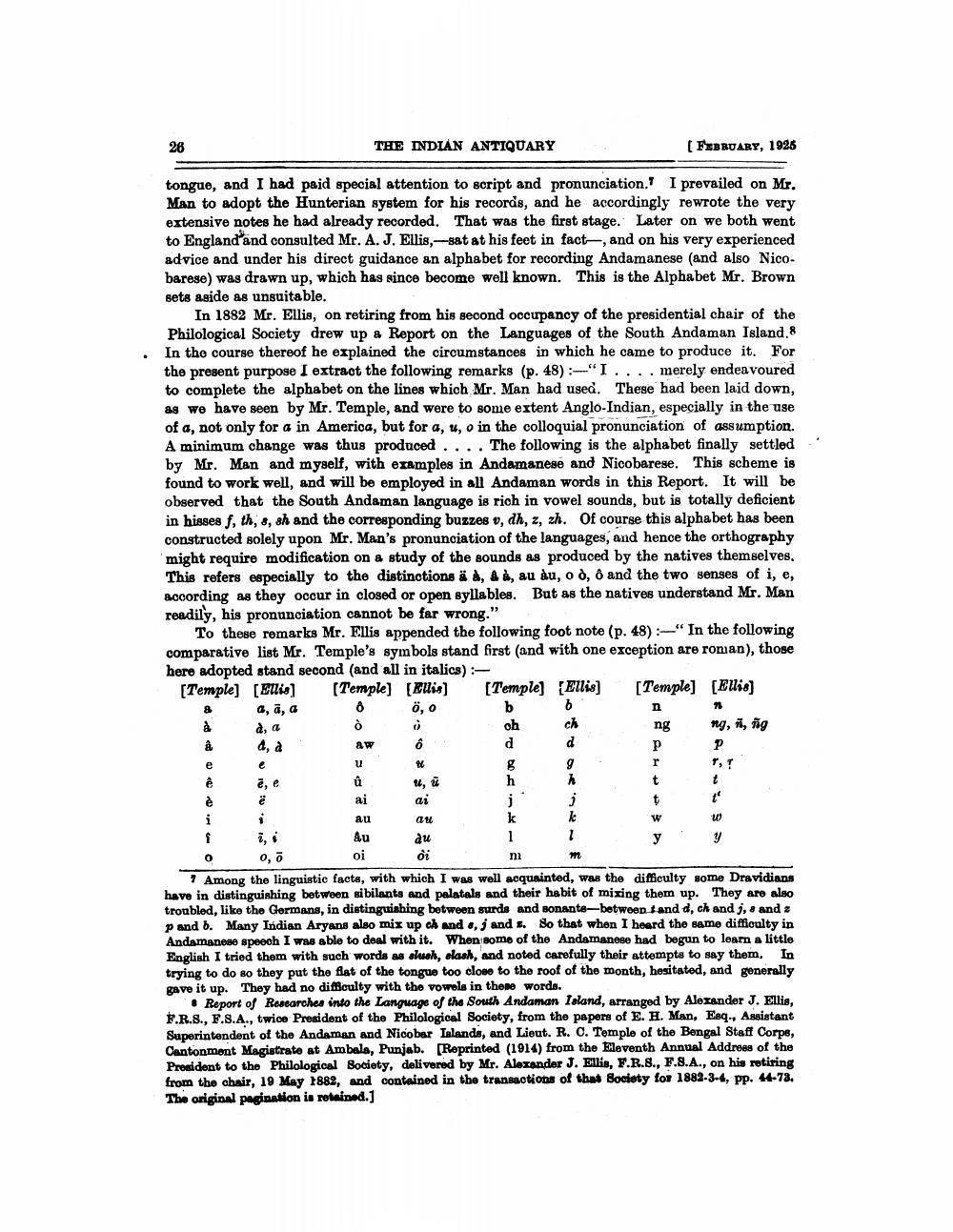________________
THE INDIAN ANTIQUARY
(FEBRUARY, 1925
tongue, and I had paid special attention to script and pronunciation.' I prevailed on Mr. Man to adopt the Hunterian system for his records, and he accordingly rewrote the very extensive notes he had already recorded. That was the first stage. Later on we both went to England and consulted Mr. A.J. Ellis,--sat at his feet in fact, and on his very experienced advice and under his direct guidance an alphabet for recording Andamanese (and also Nicobarese) was drawn up, which has since become well known. This is the Alphabet Mr. Brown sets aside as unsuitable.
In 1882 Mr. Ellis, on retiring from his second occupancy of the presidential chair of the Philological Society drew up & Report on the Languages of the South Andaman Island.8 In the course thereof he explained the circumstances in which he came to produce it. For the present purpose I extract the following remarks (p. 48) :-"I.... merely endeavoured to complete the alphabet on the lines which Mr. Man had used. These had been laid down, as we have seen by Mr. Temple, and were to some extent Anglo-Indian, especially in the use of a, not only for a in America, but for a, 4, o in the colloquial pronunciation of assumption. A minimum change was thus produced .... The following is the alphabet finally settled by Mr. Man and myself, with examples in Andamanese and Nicobarese. This scheme is found to work well, and will be employed in all Andaman words in this Report. It will be observed that the South Andaman language is rich in vowel sounds, but is totally deficient in hisses f, th, 8, sh and the corresponding buzzes o, dh, z, zh. Of course this alphabet has been constructed solely upon Mr. Man's pronunciation of the languages, and hence the orthography might require modification on a study of the sounds as produced by the natives themselves.
This refers especially to the distinctions ä à, &, au àu, oo, O and the two senses of i, e, according as they occur in closed or open syllables. But as the natives understand Mr. Man readily, his pronunciation cannot be far wrong."
To these remarks Mr. Ellis appended the following foot note (p. 48) "In the following comparative list Mr. Temple's symbols stand first (and with one exception are roman), those here adopted stand second (and all in italics) -
(Temple] [EUiA] [Temple] [Ellis) [Temple] [Edis) a, ā, a ö, o
n ch ch
ng ng, n, ñig â , a
dd
6
ë
du oi
oi
ai ai
au Au
11 0,7 7 Among the linguistic facts, with which I was well acquainted, was the difficulty some Dravidians have in distinguishing between sibilants and palatals and their habit of mixing them up. They are also troubled, like the Germans, in distinguishing between surds and sonante-between $and d, ch and j, . and p and b. Many Indian Aryans also mix up ch And , j ands. So that when I heard the same difficulty in Andamanese speech I was able to deal with it. When some of the Andamanese had begun to learn a little English I tried them with such words as shush, olash, and noted carefully their attempts to say them. In trying to do so they put the flat of the tongue too close to the roof of the month, hesitated, and generally gave it up. They had no diffoulty with the vowels in the words.
& Report of Researches into the Language of the South Andaman Island, arranged by Alexander J. Ellis, F.R.S., F.S.A., twice President of the Philological Society, from the papers of E. H. Man, Esq., Assistant Superintendent of the Andaman and Nicobar Lalands, and Lieut. R. O. Temple of the Bengal Staff Corps, Cantonment Magistrate at Ambala, Punjab. (Reprinted (1914) from the Eleventh Annual Address of the President to the Philological Society, delivered by Mr. Alexander J. Ellis, F.R.8., F.8.A., on his retiring from the chair, 19 May 1882, and contained in the transactions of that Society for 1882-3-4, pp. 44-78. The original pagination is retained.]




